Description
Sound Level & Spectrogram
![]()
"Sound Level & Spectrogram" is a sound level meter app for iPhone to easily measure the sound level of noise and music in your living environment.This app is Free of Charge. It is currently available only in Japan and the United States.
Just tap the start button to measure sound levels in decibels (dB) and display the time variation of the sound level. You can also visually check the frequency characteristics of the sound source in spectrogram.

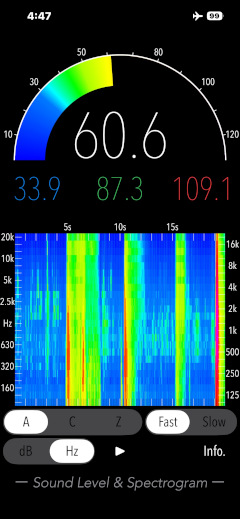
You can select between frequency weighting characteristics (A/C/Z) and time weighting characteristics (FAST/SLOW), which are essential for general sound level meters, for appropriate sound level measurement.
The world is full of sounds. Some are pleasant, others are unpleasant and harmful. The World Health Organization (WHO) has noted a direct correlation between noise and health risks. It can cause a variety of health risks, including tinnitus, sleep disturbances, stress, cognitive impairment, and heart disease.
Knowing if your noise levels are appropriate will improve your quality of life. Protect your health and comfort with this app.
We also offer "Sound Level Analyzer" app, a standard sound level measurement tool with powerful acoustic analysis features.
Please click on the link below to access "Sound Level & Spectrogram" product page in AppStoreTM.
- Communications charges when connecting to AppStore will be borne by the customer.
- iPhone is a trademark of Apple Inc., registered the United States. and other countries. AppStore is a service mark of Apple Inc.
Products Information
- Version: 3.0
- Release date: October 10, 2025 UTC
- Size: 3.0 MB
- Category: Utilities, Life style
- Compatibility: Compatible with iPhone. Requires iOS 18.7 or later.
- Status: Now distributing.
Features
"Sound Level & Spectrogram" has the following features:
- Sound level measurement (dB):
- Leq (equivalent sound level), Min (minimum value), Max (maximum value), Avg (time-averaged equivalent sound level)
- Frequency weighting correction characteristics:
A (general sound level measurement with auditory correction)
C (sound level measurement with almost flatter correction than A correction, e.g. peak evaluation at high volume)
Z (flat characteristics without auditory correction, physical sound level measurement)- Time weighting characteristics: Fast=0.125sec, Slow=1.0sec
- Display Range: 0 - 130 dB
- Measurement time: 20 sec
- Time course graph
- Spectrogram: 1/3 octave band analysis
Applications
This app can be used for various applications as follows:
- Applications
- Live Sound
- Environmental noise measurement
- Setting and Tuning of Audio system
- Installation of Audio equipments
- Installation of Car audio equipments
- Architectural acoustics
- Device management
- Example of usage scenarios
- To measure the quiet characteristics (low noise level) of home appliances.
- To measure the noise level of a household electrical appliance.
- To know the noise level of your own car, or to compare the noise level of a new car during a test drive as a consideration for purchase.
- To know the noise level of your own home or the noise level of the surrounding environment.
- To measure the noise level in the workplace.
- To check the sound level or background noise level when playing music.
Noise exposure risks
The followings are examples of sound sources and noise levels.
- Examples of sound sources and noise levels
130 dB: Engine sound of Airplane
110 dB: Horn of Car
100 dB: Noise of passing train
90 dB: In loud factory
80 dB: In the train, Vacuum cleaner
70 dB: Noisy office, Noisy street
60 dB: Quiet Car, Normal conversation
50 dB: Quiet office
40 dB: In the library, Quiet residential area
30 dB: Outskirts of midnight, Whisper
20 dB: Sounds of rubbing leavesNote: The standard noise measurement range is 30-130 dBA, and the measured value (Leq) is about 30 dBA in a quiet room of the household. Due to the presence of background noise, noise levels are never measured at 0dBA even in very quiet environments. In a typical anechoic room, the noise level is around 5-15 dBA.
The World Health Organization (WHO) has published noise level indicators related to health risks caused by noise, which are listed below as a reference for noise management.
In general, the quality of life begins to be affected at levels above 60 dB, and the risk of health problems increases at levels above 80 dB. Prolonged exposure to high levels of noise can cause temporary hearing loss, as indicated below.
- Noise level and permissible exposure time
100dB: only a few minutes/day (weekly limit of 20 minutes)
95 dB: 10 minutes/day (weekly limit 1 hour 15 minutes)
90 dB: 30 minutes/day (weekly limit 4 hours)
85 dB: 1 hour 45 minutes/day (weekly limit 12.5 hours)
80 dB: 5.5 hours/day (weekly limit 40 hours)
Important initial settings
In order for this app to work properly, it is necessary to make the following initial settings related to the iOS system.
- Microphone access permission
- App Tracking Transparency
- Leq: Equivalent sound level - Instantaneous value of sound level (noise level) (dB)
- Avg: Time average equivalent sound level - Time moving average value (dB)
- Min: Minimum sound level - Minimum value within the measurement time (dB)
- Max: Maximum sound level - Maximum value within the measurement time (dB)
- FAST: 0.125 sec (Default)
- SLOW: 1.0 sec
- A: A correction - General sound level measurement with auditory correction (Default)
- C: C correction - sound level measurement with almost flatter correction than A correction, e.g. peak evaluation at high volume
- Z: Non correction - flat characteristics without auditory correction, physical sound level measurement
- Version 3.0 was released on October 10, 2025. UTC
- Version 2.1 was released on June 10, 2025. UTC
- Version 2.0 was released on January 21, 2025. UTC
* Changed App name.
- Version 1.0 was released on June 11, 2024. UTC
- This app is adjusted the reference value for iPhone. However, the built-in microphone of your iPhone is likely to have a non-uniform gain. The more exact measurement should be calibrated using the absolute level calibration devices.
- This app is equipped with the core technology of our "Sound Level Analyzer" app series that are used around the world and enables highly reliable sound measurement. We have received the highest evaluation as a sound level meter app for smart phones in a research paper published in the international acoustic journal "Applied Acoustics". (Paper: "Testing the accuracy of smartphones and sound level meter applications for measuring environmental noise", Enda Murphy, Eoin A. King ; Applied Acoustics 106(2016)16-22.)
- Please fill in your review by accessing from iOS device.
At the initial startup after installing the app, the iOS system asks for permission to access the built-in microphone. In this case, you need to enable access to "Microphone".
If you have not enabled this setting, this app can not work by privacy restrictions of the iOS system. Please enable the access permission on the iOS setting, "Settings > Privacy & Security > Microphone".
Upon first launch, the iOS system will ask you to confirm App Tracking Transparency (ATT). Ads will be displayed with or without this permission, but if you choose to allow it, personalized ads will be delivered to you.
This app is operated by advertising revenue, so we appreciate your cooperation.
Sound Level Measurement
This app performs general sound level measurements. Setting the frequency correction and time correction appropriately, you can get the optimal sound level measurement. Tap the Start button to start the sound level measurement, and tap the Stop button to stop.
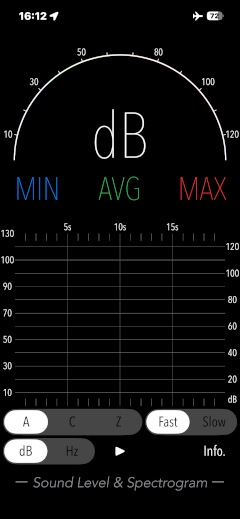
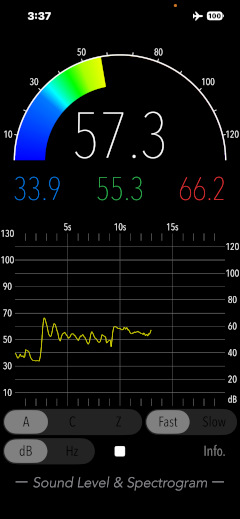
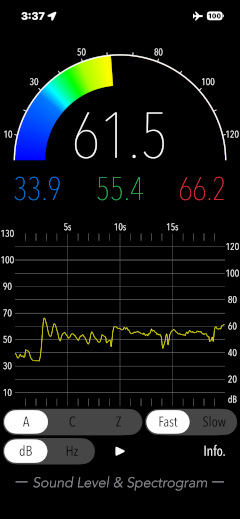
Sound level measurements are displayed measured values of Equivalent continuous sound level (Leq), minimum value (Min), maximum value (Max) and Time average equivalent sound level (Avg) in dB units. The Leq is also displayed as a color bar graph.
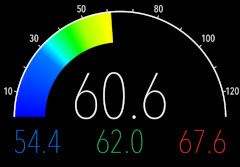
Measured values
It also displays a short-term time course graph at the same time. This graph graphically displays the time course variation of the equivalent sound level (Leq) for up to 20 seconds. When measurement is stopped, the display switches to the spectrogram. To display the time course graph, tap the dB button.
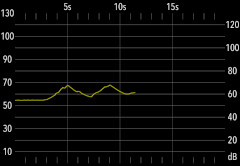
Time weightingcorrection and Frequency weighting correction can be set as measurement parameters as follows.
Time weighting correction
It specifies the time constant of calculating the sound level. Please set in accordance with the occurrence tendency and type of sound source.
Frequency weighting correction
It is a weighting filter that limits the frequency band of the input signal. Please set according to the measurement applications.
Spectrogram
After the sound level measurement is completed, a spectrogram is displayed. It is based on the frequency component analysis data obtained by FFT conversion and frequency divided into 1/3 octave bands.
The spectrogram is a graph showing the results of sound frequency spectrum analysis with time on the horizontal axis, frequency on the vertical axis, and signal strength represented by color, and is used for speech analysis, voiceprint identification, etc.
As the strength of the sound signal increases, the color changes from blue to yellow and then to red. This is useful for understanding the characteristics of the sound source.
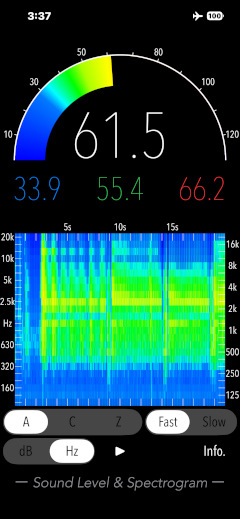
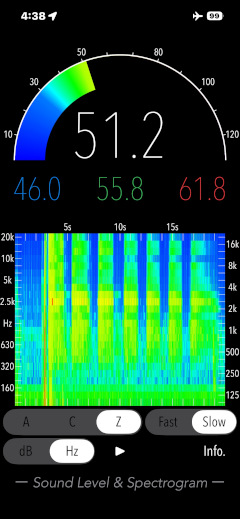
Information view
Tap Info button, it is displayed the product information and function description. The screen description can be scrolled up and down. Tap Close button, it will return to the previous measurement view.
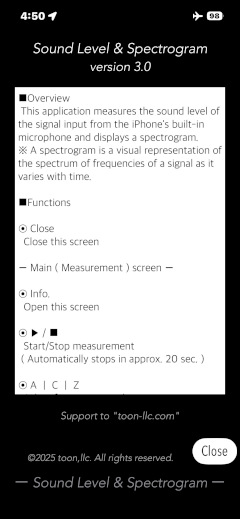
Release Information
Note
Request for review
Please send a review of your comments and requests for this app. We will use your review to improve our products. Thank you for your cooperation.
Contact us
For inquiries and consultation regarding our iOS app products, please contact the following support desk.
About Inquiries toon,llc.
toon,llc. Return to Top
Return to Top